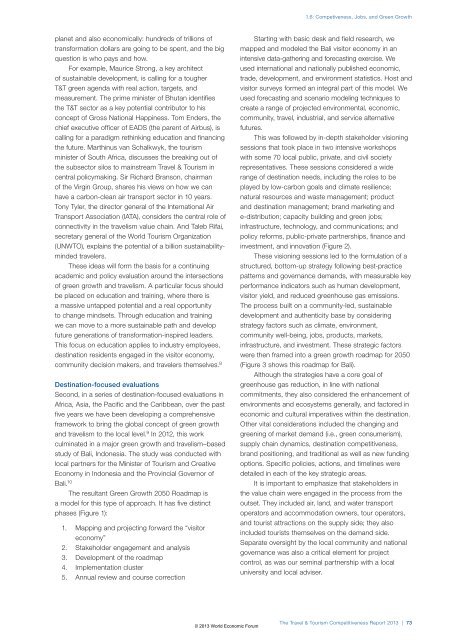The Travel & Tourism Competitiveness Report 2013
The Travel & Tourism Competitiveness Report 2013
The Travel & Tourism Competitiveness Report 2013
Create successful ePaper yourself
Turn your PDF publications into a flip-book with our unique Google optimized e-Paper software.
planet and also economically: hundreds of trillions of<br />
transformation dollars are going to be spent, and the big<br />
question is who pays and how.<br />
For example, Maurice Strong, a key architect<br />
of sustainable development, is calling for a tougher<br />
T&T green agenda with real action, targets, and<br />
measurement. <strong>The</strong> prime minister of Bhutan identifies<br />
the T&T sector as a key potential contributor to his<br />
concept of Gross National Happiness. Tom Enders, the<br />
chief executive officer of EADS (the parent of Airbus), is<br />
calling for a paradigm rethinking education and financing<br />
the future. Marthinus van Schalkwyk, the tourism<br />
minister of South Africa, discusses the breaking out of<br />
the subsector silos to mainstream <strong>Travel</strong> & <strong>Tourism</strong> in<br />
central policymaking. Sir Richard Branson, chairman<br />
of the Virgin Group, shares his views on how we can<br />
have a carbon-clean air transport sector in 10 years.<br />
Tony Tyler, the director general of the International Air<br />
Transport Association (IATA), considers the central role of<br />
connectivity in the travelism value chain. And Taleb Rifai,<br />
secretary general of the World <strong>Tourism</strong> Organization<br />
(UNWTO), explains the potential of a billion sustainabilityminded<br />
travelers.<br />
<strong>The</strong>se ideas will form the basis for a continuing<br />
academic and policy evaluation around the intersections<br />
of green growth and travelism. A particular focus should<br />
be placed on education and training, where there is<br />
a massive untapped potential and a real opportunity<br />
to change mindsets. Through education and training<br />
we can move to a more sustainable path and develop<br />
future generations of transformation-inspired leaders.<br />
This focus on education applies to industry employees,<br />
destination residents engaged in the visitor economy,<br />
community decision makers, and travelers themselves. 8<br />
Destination-focused evaluations<br />
Second, in a series of destination-focused evaluations in<br />
Africa, Asia, the Pacific and the Caribbean, over the past<br />
five years we have been developing a comprehensive<br />
framework to bring the global concept of green growth<br />
and travelism to the local level. 9 In 2012, this work<br />
culminated in a major green growth and travelism–based<br />
study of Bali, Indonesia. <strong>The</strong> study was conducted with<br />
local partners for the Minister of <strong>Tourism</strong> and Creative<br />
Economy in Indonesia and the Provincial Governor of<br />
Bali. 10<br />
<strong>The</strong> resultant Green Growth 2050 Roadmap is<br />
a model for this type of approach. It has five distinct<br />
phases (Figure 1):<br />
1. Mapping and projecting forward the “visitor<br />
economy”<br />
2. Stakeholder engagement and analysis<br />
3. Development of the roadmap<br />
4. Implementation cluster<br />
5. Annual review and course correction<br />
© <strong>2013</strong> World Economic Forum<br />
1.6: Competiveness, Jobs, and Green Growth<br />
Starting with basic desk and field research, we<br />
mapped and modeled the Bali visitor economy in an<br />
intensive data-gathering and forecasting exercise. We<br />
used international and nationally published economic,<br />
trade, development, and environment statistics. Host and<br />
visitor surveys formed an integral part of this model. We<br />
used forecasting and scenario modeling techniques to<br />
create a range of projected environmental, economic,<br />
community, travel, industrial, and service alternative<br />
futures.<br />
This was followed by in-depth stakeholder visioning<br />
sessions that took place in two intensive workshops<br />
with some 70 local public, private, and civil society<br />
representatives. <strong>The</strong>se sessions considered a wide<br />
range of destination needs, including the roles to be<br />
played by low-carbon goals and climate resilience;<br />
natural resources and waste management; product<br />
and destination management; brand marketing and<br />
e-distribution; capacity building and green jobs;<br />
infrastructure, technology, and communications; and<br />
policy reforms, public-private partnerships, finance and<br />
investment, and innovation (Figure 2).<br />
<strong>The</strong>se visioning sessions led to the formulation of a<br />
structured, bottom-up strategy following best-practice<br />
patterns and governance demands, with measurable key<br />
performance indicators such as human development,<br />
visitor yield, and reduced greenhouse gas emissions.<br />
<strong>The</strong> process built on a community-led, sustainable<br />
development and authenticity base by considering<br />
strategy factors such as climate, environment,<br />
community well-being, jobs, products, markets,<br />
infrastructure, and investment. <strong>The</strong>se strategic factors<br />
were then framed into a green growth roadmap for 2050<br />
(Figure 3 shows this roadmap for Bali).<br />
Although the strategies have a core goal of<br />
greenhouse gas reduction, in line with national<br />
commitments, they also considered the enhancement of<br />
environments and ecosystems generally, and factored in<br />
economic and cultural imperatives within the destination.<br />
Other vital considerations included the changing and<br />
greening of market demand (i.e., green consumerism),<br />
supply chain dynamics, destination competitiveness,<br />
brand positioning, and traditional as well as new funding<br />
options. Specific policies, actions, and timelines were<br />
detailed in each of the key strategic areas.<br />
It is important to emphasize that stakeholders in<br />
the value chain were engaged in the process from the<br />
outset. <strong>The</strong>y included air, land, and water transport<br />
operators and accommodation owners, tour operators,<br />
and tourist attractions on the supply side; they also<br />
included tourists themselves on the demand side.<br />
Separate oversight by the local community and national<br />
governance was also a critical element for project<br />
control, as was our seminal partnership with a local<br />
university and local adviser.<br />
<strong>The</strong> <strong>Travel</strong> & <strong>Tourism</strong> <strong>Competitiveness</strong> <strong>Report</strong> <strong>2013</strong> | 73

















